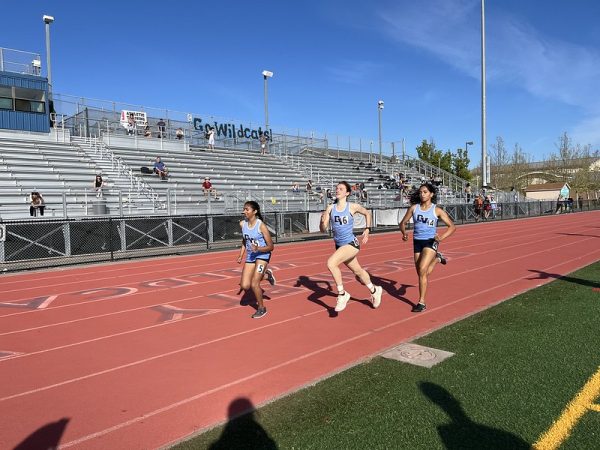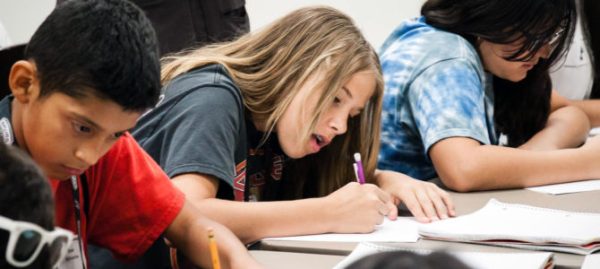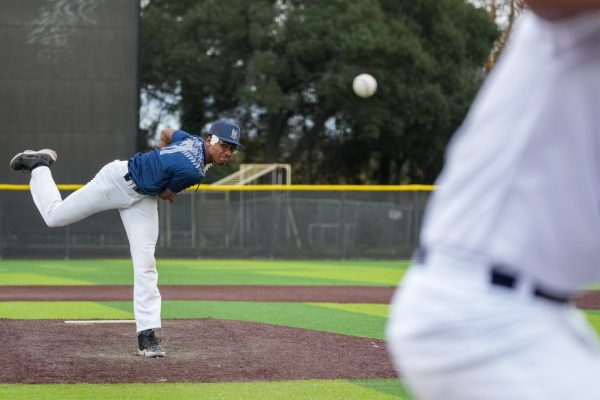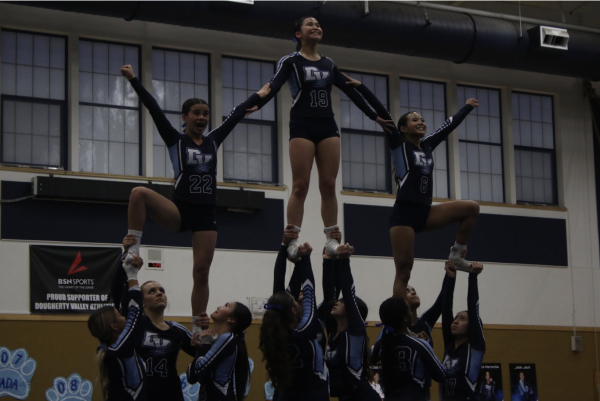Considering a ban on semi-automatic guns
March 25, 2018
We hoped it wouldn’t happen again, but it did.
Since the tragedy that was Sandy Hook, mass shootings have cemented themselves into routine, permeating our news feeds with periodic cycles of mourning and inaction. Most recently, in Parkland, Fla., a gunman killed 17 people in a six-minute rampage at Marjory Stoneman Douglas High School.
As usual, the shooting has reignited the gun debate. And this time, perhaps due to the survivors’ impassioned calls for reform, meaningful gun control legislation is actually on the table.
Given this revitalized conversation, it would be a grave mistake to not seriously consider banning the private ownership of semiautomatic weapons — weapons that fire one bullet and automatically reload with each pull of the trigger, including everything from assault weapons to handguns. To clarify, shooting ranges and hunting grounds (with significant regulations and public oversight) could still be empowered to keep stores of weapons on site for gun enthusiasts to use — it’s just the private, individual ownership that presents an issue.
While we all can get behind soft reforms like universal background checks, mental health studies and voluntary buybacks, all these changes are not enough. To be sure, prohibiting such a wide variety of firearms is an unpopular political position — for example, a poll conducted by The Economist on Feb. 25 indicated that close to 50 percent of Democrats and 80 percent of Republicans opposed restricting access to handguns, let alone all semi-automatics. However, barring ownership of guns, including handguns, is a long-term necessity for reducing gun violence, preventing both high-profile mass-shootings and average homicides.
First, let’s address the assault weapons. A Feb. 15 op-ed by Jacob Sullum, senior editor of the right-wing Reason magazine, maintains that “legislators’ ‘assault weapons’ definitions … are based on appearance rather than lethality.” Our proposal is to ban all semi-automatic weapons, thereby encompassing all “assault rifles,” which means an ill-informed definition is not a problem.
Additionally, assault weapons such as AR-15s are undeniably lethal, and their regulation is not just a matter of appearance.
Heather Sher, a radiologist who treated the Parkland victims, writes, “[AR-15] bullets … are different. They travel at a higher velocity and are far more lethal than routine bullets fired from a handgun.”
Sher described victims’ organs as “shreds” reminiscent of “an overripe melon smashed by a sledgehammer.” Unlike handgun bullets, AR-15 bullets don’t have to hit an artery to be fatal; victims often die from blood loss before making it to the trauma center.
Thus, perpetrators don’t have to be skilled or precise in order to kill large numbers of people. A WIRED article praised AR-15s as particularly “ergonomic,” and characterized by “easy handling” — words that you wouldn’t want to use to describe an active shooter’s weapon. Range, of course, is another issue — enabling perpetrators to effectively combat police. Furthermore, assault weapons are highly modular, meaning that they can be customized with additions such as bump stocks that convert them into fully automatic weapons. So despite sharing semi-automatic characteristics, assault weapons are significantly more dangerous than other firearms. Banning them would surely decrease both the number and body count of mass shootings.
While banning assault weapons is a necessary first step, it is useless without also passing a handgun ban.
Handguns contributed to 65 percent of the 9,616 firearm homicides in 2016, far outnumbering the death toll from AR-15s. Their usage in cases of violent crime exceeds that of all other firearms. Handguns are effective tools for criminals because they are cheap, easy to use and concealable. Substitution is highly unlikely after the ban because it simply isn’t feasible to discreetly commit most crime using long guns.
But beyond that, suicides constitute the majority of lives lost due to gun violence; every year, over 21,000 Americans die by gun suicide. As one can imagine, attempting suicide using a firearm is almost always fatal. Antonio R. Andres of the VSB-Technical University of Ostrava and Katherine Hempstead of the Robert Wood Johnson Foundation state that “much of the decline in suicide in the United States over the past decades has been linked to the reduced prevalence of firearms.” Handguns are the primary culprit, causing 49.9 percent of all firearm suicide deaths according to the American Foundation for Suicide Prevention. And it’s a myth that without access to a gun, suicidal people will find a way regardless — intense suicidal thoughts are often temporary, so any barrier to a suicide weapon could save lives.
What about self-defense? Shouldn’t people be able to possess a small pistol or revolver? It’s a common and intuitive argument, but ultimately one that falters in the face of both statistics and anecdotal evidence. The self-defense myth peddled by the NRA has been proven to be massively overstated and overreported.
Self-defense is self-defeating. The American Foundation for Suicide Prevention states that “the handgun bought for self-protection is far more likely to be used against the owner or someone known to the owner — in a homicide (usually as the result of an argument), a suicide, or an unintentional shooting — than in legitimate self-defense.” There are plenty of examples of people killing themselves or others by accident, including the recent unintended shooting death of 18-year-old aspiring nurse Courtlin Arrington at an Alabama high school.
There have certainly been instances where people have used handguns to defend themselves. But this kind of anecdotal evidence of people using a firearm to protect themselves against an intruder is skewed, because it ignores vital context. According to the American Journal of Lifestyle Medicine, owning a handgun makes one more likely to become target in the first place — consequently making it more likely that you will end up having to use said handgun in “self-defense.” The journal indicates that the statistically determined possibility of using a gun against a criminal during a crime will occur “zero times” for the average person — an infinitesimal probability. It’s also highly possible that an unarmed intruder will successfully seize and obtain possession of the homeowner’s legally-held firearm, escalating the stakes of a home invasion.
So it’s not surprising that these “self-defense” incidents often do not end well. A Harvard analysis of the federal National Crime Victimization Survey shows that “the likelihood of injury when there was a self-defense gun use (10.9 percent) was basically identical to the likelihood of injury when the victim took no action at all (11.0 percent).”
It is important to note that while the number of uses of guns in self defense are widely disputed, the NCVS, conducted from 2007 to 2011, had a sample size of 160,000 of which 127 people reported using a gun in self defense. Compared to the most prominent study touted by conservatives (the Kleck-Gertz survey in the 1990s), it has a sample size 3100 percent greater and is far more recent.
The last line of defense against gun control remains the Constitution. The Second Amendment as commonly interpreted is wrong — it clearly only outlines firearm usage for militias. The purpose of the Second Amendment was to allow for a citizen militia to ostensibly rise up against an authoritarian government. But, the probability of tyranny is so low that its use as a justification for the continuation of complacency is laughable. The Second Amendment does not allow for blanket gun ownership.
The Constitution is not absolute even in the status quo — “strict scrutiny” allows for an unconstitutional law to remain in place as long as it presents a “compelling government interest,” which a gun ban would.
But in order to justify its benefits, the logistics of this ban must be different this time. The reason why previous regulations were ineffective is not because gun control as an idea is ineffective, but rather because the wording of bills allowed for the owning of guns and gun accessories that were made illegal as long as they were bought before the passage of the law.
It is this grandfather clause that allows for the perpetuation of the black market after a ban. It is crucial that we implement a system of mandatory buybacks to eliminate this loophole. Australia used the system after it passed sweeping gun regulations similar to a semiautomatic weapon ban after the Port Arthur Massacre of 1996. The Washington Post states that “there were 13 mass shootings in the 17 years prior to the passage of the National Firearms Agreement [by Australia]. Since then, there hasn’t been a single one.”
There do remain some other objections to bans, with fingers pointing at Chicago or D.C. as examples of where gun bans have failed. It’s important to remember, however, that these bans were not applied nationwide, allowing for circumvention by buying firearms from outside the area where the law was enacted. The plan we propose must be implemented federally.
Andrew Leigh of the Australian National University and Christine Neill of Wilfrid Laurier University state that “the fact that [the National Firearms Agreement] applied across the nation meant that gun owners could not simply travel across jurisdictions to purchase a replacement firearm, as can occur in the case of the more limited buybacks.”
Buybacks also solve for a majority of the “black market” that conservatives mention because the illicit market derives its supply from the legal market — often through theft or straw purchasing, an explanation supported by the National Institute of Justice. Drying up the legal supply prevents illicit channels.
But if the benefits are so clear-cut, why hasn’t legislation been passed? In the months surrounding the 1993 San Francisco shooting, California Senator Dianne Feinstein proposed a bill outlining a comprehensive assault weapons ban. The list included 670 firearms, and upon effect, would have rendered countless firearms useless in the hands of law-abiding citizens. However, lurking in the shadows, coiled up and ready to pounce, were the NRA lobbyists, who tore the bill apart line by line before it even had a chance to run through Congress. A list of 670 soon became 19, and a bill with real potential to inspire change was reduced to a frail shadow of itself. The 1994 Assault Weapons Ban did eventually pass, but it, like so many others, was ineffective and strife with loopholes. It expired 10 years later.
At the root of this problem are the NRA lobbyists, whose sole purpose in this context seems to be to impede any and all gun control legislation headed towards Congress. NRA gun lobbyists pull the strings, and their GOP allies cower in fear as they do so. The NRA bestows grants of hundreds of thousands of dollars to politicians on both sides of the aisle, buying not only their support but their silence.
In 2017 alone, 24 full time NRA lobbyists lobbied for more than 200 bills, spending upwards of $5.1 million to do so. In addition to lobbying expenditures, NRA electoral spending last year reached an astounding $54 million, in the form of donations to Republican candidates.
The NRA diligently supervises everything related to gun control happening in Congress — nothing happens without their knowledge and consent. In Florida, for example, legislators and political analysts make sure to run any changes to legislation by NRA lobbyist Marion Hammer before even thinking about passing the bill, according to email records obtained by The New Yorker. Their deference to her is clear. And it highlights the overarching problem: that legislators and politicians are being persuaded by money to sway to the tune of their charmer — the NRA.
If a shooting occurs, then a bill will be proposed. It will be brought down by lobbyists, and the issue will be brought up again only when another shooting happens. It’s a cycle of inaction and cynicism that has defined our modern politics.
But never again.
We simply cannot afford to be vague in our response to guns in America. Every time there is a delay in Congress or every time a mediocre gun control bill is proposed, we risk losing another life. We’re treading water right now, and before we’re dragged back underneath by yet another tragedy, we need to do something. Guns don’t save lives, they only take them. And this cycle of violence is just perpetuated by the existence of guns for the foolish fallacy that they serve to protect, while in reality, they only endanger us.
This movement, this push for reform, will not end with Parkland, and our fight to keep every American safe will not stop.












